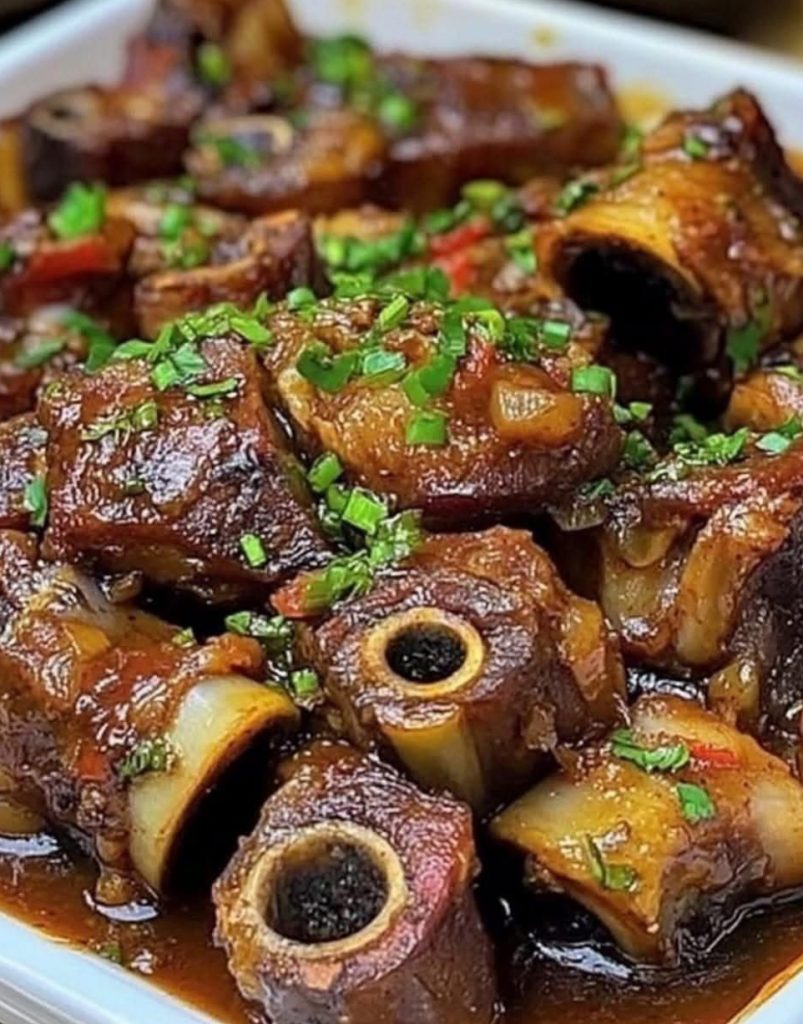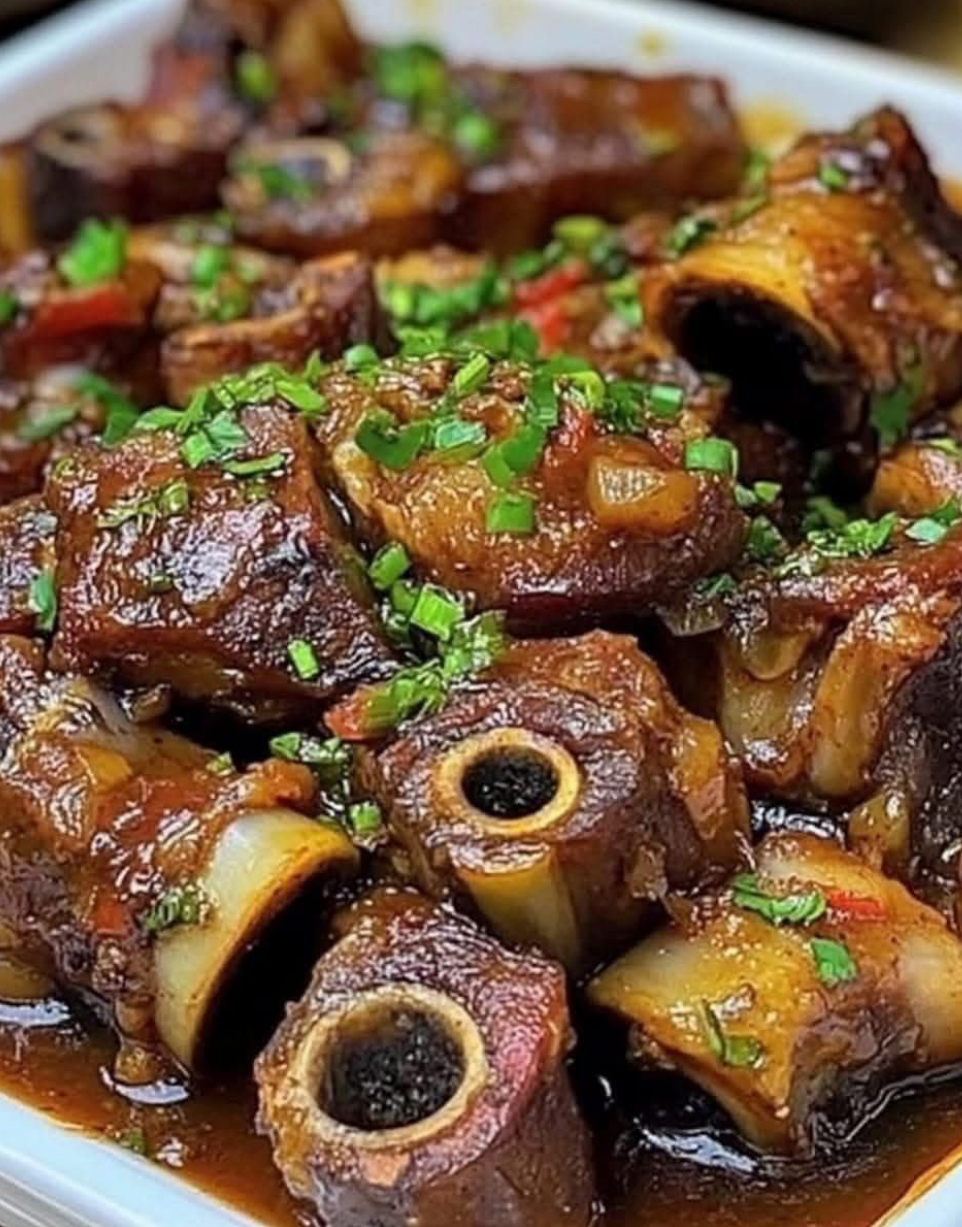
Introduction
Oxtail is a beloved dish in various cuisines worldwide, known for its tender meat and rich, flavorful sauce. This recipe brings the tradition to your table, blending aromatic spices and hearty vegetables to create a melt-in-your-mouth experience. Perfect for family dinners or special occasions, this dish is bound to win hearts.
Ingredients
Main Ingredients:
- 2 lbs (900g) oxtail, cut into pieces
- 2 tbsp olive oil
- 1 large onion, diced
- 4 garlic cloves, minced
- 2 medium carrots, chopped
- 1 red bell pepper, diced
- 2 tbsp tomato paste
- 2 cups beef stock
- 1 cup red wine (optional, for added depth)
- 2 tbsp Worcestershire sauce
- 1 tsp smoked paprika
- 1 tsp thyme
- 2 bay leaves
- Salt and pepper to taste
Garnish:
- Fresh parsley or chives, finely chopped
Instructions
- Preparation:
- Rinse the oxtail pieces under cold water and pat them dry with paper towels.
- Season with salt and pepper.
- Searing:
- Heat olive oil in a large skillet or Dutch oven over medium-high heat.
- Brown the oxtail pieces on all sides (about 3-4 minutes per side). Set aside.
- Sautéing:
- In the same skillet, add onions, garlic, carrots, and red bell pepper.
- Cook until softened, about 5 minutes.
- Building the Sauce:
- Stir in the tomato paste and cook for 2 minutes.
- Deglaze the pan with red wine, scraping up the browned bits. Let it simmer for 3 minutes.
- Add beef stock, Worcestershire sauce, smoked paprika, thyme, and bay leaves. Stir to combine.
- Simmering:
- Return the seared oxtail to the pot.
- Cover and simmer on low heat for 2-3 hours until the meat is fork-tender. (Alternatively, use a slow cooker on low for 6-8 hours.)
- Thickening the Sauce:
- If the sauce is too thin, remove the lid during the last 20 minutes of cooking.
- Adjust seasoning with more salt or pepper, if needed.
- Serving:
- Plate the oxtail with the rich sauce and garnish with fresh parsley or chives.
Methods
- Searing: Locks in the meat’s flavor.
- Low and Slow Cooking: Ensures tenderness.
- Deglazing: Enhances the sauce with deep, caramelized flavors
To achieve tender, flavorful oxtail, a few tried-and-true cooking methods are commonly used. Here’s a breakdown of these techniques:
1. Braising (Slow Cooking in Liquid)
This is the most popular method for preparing oxtail and ensures the meat becomes tender and flavorful.
- Steps:
- Sear the oxtail in a hot pan until browned on all sides.
- Add aromatics like onions, garlic, and herbs.
- Pour in liquid (broth, wine, or water) and simmer slowly over low heat for several hours.
- The result is tender, fall-off-the-bone meat with a rich, savory sauce.
- Best For: Traditional stews, soups, or Jamaican-style oxtail recipes.
2. Pressure Cooking
For quicker results, a pressure cooker or Instant Pot can be used to tenderize oxtail in a fraction of the time.
- Steps:
- Brown the oxtail in the pressure cooker.
- Add your seasonings, vegetables, and cooking liquid.
- Cook under pressure for 45–60 minutes, depending on the size of the pieces.
- Reduce the sauce after cooking for a thicker, more concentrated flavor.
- Best For: Time-efficient preparation without compromising tenderness.
3. Slow Cooking (Crockpot)
For a set-it-and-forget-it option, the slow cooker is ideal.
- Steps:
- Brown the oxtail in a skillet before transferring it to the slow cooker.
- Add vegetables, spices, and liquid.
- Cook on low for 8–10 hours or high for 4–6 hours until tender.
- Best For: Busy days when you want a hearty meal ready by dinner.
4. Roasting/Baking
Roasting oxtail in the oven enhances its flavor and caramelizes the exterior.
- Steps:
- Season and sear the oxtail on the stovetop.
- Transfer to a roasting pan with vegetables and liquid.
- Cover and bake at 325°F (160°C) for 3–4 hours.
- Best For: Creating a deeply caramelized and flavorful dish.
5. Stove-Top Stewing
Cooking oxtail entirely on the stovetop allows for constant monitoring and adjustments to seasoning.
- Steps:
- Sear the oxtail in a heavy-bottomed pot.
- Add aromatics and cooking liquid.
- Simmer on low heat for 3–4 hours, stirring occasionally to prevent sticking.
- Best For: Traditional stews and soups.
6. Smoking (For BBQ-Style Oxtail)
Smoking oxtail adds a smoky depth of flavor before or after braising.
- Steps:
- Season and smoke the oxtail at 225°F (107°C) for 2–3 hours.
- Transfer to a pot with liquid and finish braising for tenderness.
- Best For: BBQ enthusiasts seeking a unique twist.
Tips for All Methods
- Marinate: Marinating oxtail overnight enhances flavor.
- Deglaze: After searing, use wine, broth, or vinegar to scrape up browned bits for added depth.
- Skim Fat: Oxtail is rich in fat; skim off excess grease for a cleaner sauce.
- Serve: Pair with mashed potatoes, rice, or crusty bread to soak up the rich sauce.
Each method brings out a unique characteristic of oxtail, but slow braising remains the favorite for unlocking its full potential.
History
Oxtail originated as a traditional dish in European and African cuisines. It was initially a frugal meal, using every part of the animal. Over time, it evolved into a gourmet dish cherished for its rich flavors and cultural significance
Oxtail, once considered a humble cut of meat, has a fascinating history rooted in frugality, cultural traditions, and culinary evolution. The term “oxtail” originally referred to the tail of an ox, though today it can come from the tails of cows as well. Its story spans continents, reflecting its versatility and universal appeal.
Origins
The use of oxtail dates back to ancient times when every part of an animal was utilized to minimize waste. It was a staple in European, African, and Asian cuisines, often prepared by peasants who relied on creative cooking methods to make tough cuts tender and flavorful.
European Influence
- England: Oxtail soup, a hearty and comforting dish, became popular in 17th-century England. Immigrants brought the recipe to London, combining influences from French and Dutch cuisines.
- France: In French cuisine, oxtail was incorporated into stews like pot-au-feu, a classic slow-cooked dish showcasing the tail’s rich flavors.
African Heritage
Oxtail holds a special place in African culinary traditions. It was introduced to the Americas during the transatlantic slave trade, where enslaved Africans used it to create flavorful dishes with minimal ingredients. Today, oxtail is central to many Caribbean recipes, reflecting African influence.
Caribbean and Jamaican Cuisine
- In Jamaica, oxtail is seasoned with bold spices, slow-cooked, and often served with rice and peas. It’s considered a celebratory dish, symbolizing comfort and abundance.
- Caribbean oxtail recipes often include Scotch bonnet peppers, allspice, and thyme, creating a dish bursting with flavor.
Asian Influence
In Asia, oxtail is a key ingredient in soups and stews:
- Korea: Kkori-gomtang, a milky oxtail soup, is enjoyed for its nourishing and restorative qualities.
- Indonesia: Sop buntut, a spiced oxtail soup, is a beloved dish showcasing Southeast Asian flavors.
Modern-Day Popularity
Today, oxtail is considered a delicacy in many parts of the world. With the rise of slow cooking and pressure cooking techniques, it has become a gourmet ingredient celebrated for its depth of flavor and rich texture. Once a budget-friendly choice, oxtail is now often a premium-priced cut due to its demand and versatility.
Oxtail’s journey from a thrifty necessity to a sought-after delicacy reflects its cultural significance and timeless appeal. It remains a dish that brings people together, honoring the past while satisfying the modern palate.
Benefits
- Rich in Collagen: Supports joint and skin health.
- Iron and Protein: Provides energy and muscle repair.
- Comfort Food: A hearty, warming dish perfect for cold days.
Benefits of Braised Oxtail
- Rich Source of Protein
- Oxtail is packed with high-quality protein essential for muscle growth, repair, and overall body strength. It helps maintain lean muscle mass and supports tissue regeneration.
- Collagen and Gelatin Content
- Oxtail is rich in collagen and gelatin, which are excellent for joint health, skin elasticity, and digestive support. Collagen helps keep your skin youthful and supports joint flexibility.
- Rich in Vitamins and Minerals
- Contains essential nutrients like iron, zinc, phosphorus, and vitamin B12.
- Iron: Helps prevent anemia and boosts energy.
- Zinc: Strengthens the immune system and aids in wound healing.
- Phosphorus: Supports strong bones and teeth.
- Vitamin B12: Enhances brain function and red blood cell production.
- Boosts Gut Health
- The gelatin in oxtail helps repair the gut lining, improving digestion and absorption of nutrients.
- Supports Bone Health
- The slow cooking process extracts minerals like calcium and magnesium from the bones, supporting healthy bones and teeth.
- Promotes Satiety
- The high protein and fat content make it a satisfying meal, keeping you full longer and reducing overeating.
- Anti-Inflammatory Benefits
- Slow-cooked bone-based dishes are known for their anti-inflammatory properties, aiding in recovery from illnesses or injuries.
- Comfort Food for Emotional Well-Being
- Oxtail’s rich, hearty flavors evoke comfort, helping reduce stress and promoting a sense of warmth and satisfaction.
- Perfect for Recovery
- Ideal for those recovering from illnesses or injuries due to its nutrient density, energy-boosting properties, and easy-to-digest nature.
- Supports Cultural Heritage
- This dish connects people to their roots, celebrating culinary traditions and fostering a sense of community through shared meals.
Braised oxtail not only satisfies the palate but also nourishes the body and soul with its rich flavors and wholesome nutrients!
Nutrition (Per Serving)
- Calories: 420
- Protein: 32g
- Fat: 25g
- Carbohydrates: 10g
- Fiber: 2g
- Sodium: 780mg
Information (Per)
- Calories: 420
- Protein: 32g
- Fat: 25g
- Saturated Fat: 10g
- Monounsaturated Fat: 8g
- Polyunsaturated Fat: 2g
- Cholesterol: 100mg
- Carbohydrates: 10g
- Dietary Fiber: 2g
- Sugars: 4g
- Sodium: 780mg
- Potassium: 450mg
- Calcium: 40mg (4% DV)
- Iron: 4mg (22% DV)
- Zinc: 6mg (40% DV)
- Vitamin B12: 3µg (125% DV)
Key Nutritional Highlights
- High in Protein
- Supports muscle repair, growth, and overall energy levels.
- Healthy Fats
- Includes essential fats for energy and satiety, with some saturated fat for flavor.
- Rich in Micronutrients
- Iron: Helps prevent anemia and boosts oxygen transport in the blood.
- Zinc: Strengthens immunity and promotes healing.
- Vitamin B12: Vital for brain function and red blood cell production.
- Low in Carbohydrates
- Suitable for low-carb or ketogenic diets when served with vegetables instead of grains.
- Calcium and Potassium
- Supports bone strength and electrolyte balance.
Note: Nutritional values can vary depending on the specific cut of oxtail, cooking methods, and additional ingredients used. For a lighter version, you can skim the fat from the sauce before serving.
Conclusion
Braised oxtail is a celebration of flavor, tradition, and comfort. This dish will become a staple for gatherings or a personal treat. Serve it over creamy mashed potatoes, steamed rice, or crusty bread for a complete meal.
Lovers of Oxtail
This dish is adored worldwide, from Jamaican-style spicy oxtail to French-style “Queue de Boeuf.” Anyone who loves tender, fall-off-the-bone meat will appreciate this hearty recipe.
Enjoy this journey of culinary tradition, and let the flavors speak for themselves!
